In June 2013, Steve Fradkin hiked the rugged coast of Washington State’s Olympic National Park to count the stars. In the summertime, the lowest tides expose the slippery rocks of the intertidal zone from daybreak until noon. Perfect conditions for spotting Pisaster ochraceus, the five-armed purple, orange and red sea stars common to Pacific waters along the western edge of the United States.
Each summer, Fradkin, a marine ecologist for the National Park Service, returns to four plots along this 65-mile stretch of protected shoreline to take inventory. The ochre star, as Pisaster is known, is an important predator in Olympic’s coastal ecosystem. Fradkin has been monitoring the population since 2008.
The moment he arrived at the first plot that June, Fradkin knew something was off. Many of the stars had gooey-white lesions across large patches of their skin. Some were missing a limb, or two or three. Disembodied arms crawled around the rocks by themselves. Other stars had fallen apart altogether, their melted carcasses scattered about the plot.
“It looked pretty much like a horror show,” Fradkin said, describing the mess.
As he worked his way north through the remaining plots, Fradkin saw the same picture everywhere. About one in every four stars showed obvious signs of sickness.
Back at his office, Fradkin picked up the phone and began reaching out to other ecologists along the Washington coast to find out if their stars were in the same dire shape.
When Fradkin made those calls in June of 2013, none of his contacts had seen anything like what he was describing. By the end of the summer, they all had. The sickness had hit Washington’s Puget Sound and Salish Sea inlets with devastating effects. Shortly after, it was spotted up and down the California coast. In 2014, it popped up in Oregon.
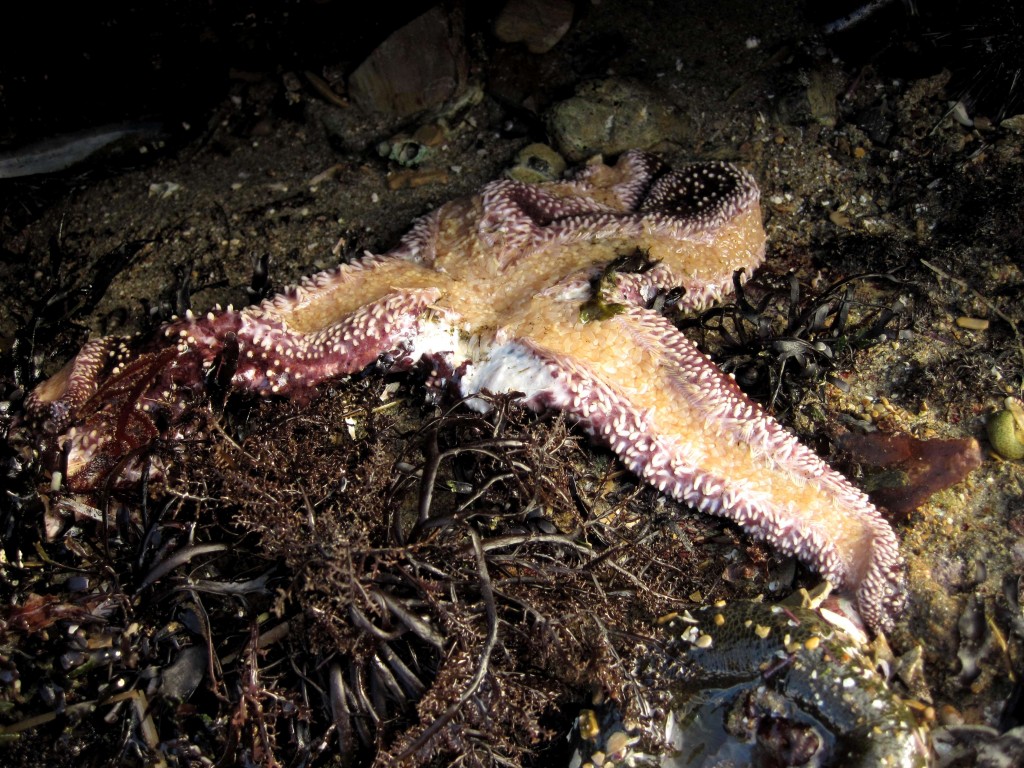
Sea Star Wasting Disease, as it became known, quickly reached epidemic proportions. Afflicting over 20 species from Alaska to Baja, California, the disease reduced stars to five percent of their original population in some regions. Tide pools along California’s central coast saw ochre star communities decimated in a matter of months. And Pycnopodia helianthoides, the 16- to 24-armed iridescent sunflower star, looked poised for extinction.
Despite calling Sea Star Wasting Disease the largest marine epidemic in recorded history, scientists had no clear explanation for what was causing it. Little is known about the viruses and bacteria that inhabit ocean ecosystems, and not a single one had been identified in sea stars. Before 2013, no one had even looked.
“It’s sort of a big detective story,” Fradkin said about solving the mystery of the wasting stars. “And it’s certainly ongoing.”
[dropcap letter=”I”]n August 2013, news of the outbreak in Olympic reached a 35-year-old marine microbiologist out of Cornell University named Ian Hewson. The young scientist had just completed a study using metagenomics, a process by which DNA is extracted and mapped from tissue samples, to identify a virus in sea urchins off Hawaii’s Big Island. It was the first virus ever detected in an echinoderm, the group of species that includes urchins, sea stars and sand dollars.
If anyone could find the cause of Sea Star Wasting Disease, it was Hewson.
Hewson was initially skeptical that some sea star super plague had emerged. He thought the signs pointed to an isolated incident caused by a chemical pollutant. When fertilizers and other nitrogen-rich contaminates enter the ocean via runoff or dumping, oxygen levels in the water drop. Without enough oxygen, Hewson hypothesized, the stars might fall sick and waste away.
Then he began hearing news of wasting outside the Olympic region. Reports from 250 miles north in Vancouver were particularly troubling. The disease had penetrated the Vancouver Aquarium, which intakes sea water from the nearby sound. Once the first signs of wasting appeared, a star’s condition could decline in a matter of hours. Within a few days, it could go from asymptomatic to completely gone.
The initial outbreak of Sea Star Wasting Disease killed all 18 of the aquarium’s sunflower stars, along with dozens of others spread across different species.
In what Hewson describes as a “flurry of emails” from research groups up and down the coast, a pattern started to emerge. The way the disease spread in waves through regions of coastline was indicative of a transmissible agent, possibly a bacteria or virus.
There was another giveaway that the disease was passing from animal to animal. Sea stars are opportunistic predators that have been known to cannibalize other stars. Now researchers were observing healthy stars feasting on the discarded limbs and melting carcasses of the dying.
Hewson and his team went to work with the techniques they had refined in Hawaii. Using both healthy and diseased specimens collected from various points along the coast, they began sequencing every possible virus found in the tissues. If they could find differences in the viral makeup of sick stars versus healthy ones, they might be able to hone in on a culprit.
With the study underway, Hewson, a field biologist by nature, decided it was time to get out of the confines of his laboratory in Ithaca, New York to experience the wasting firsthand.
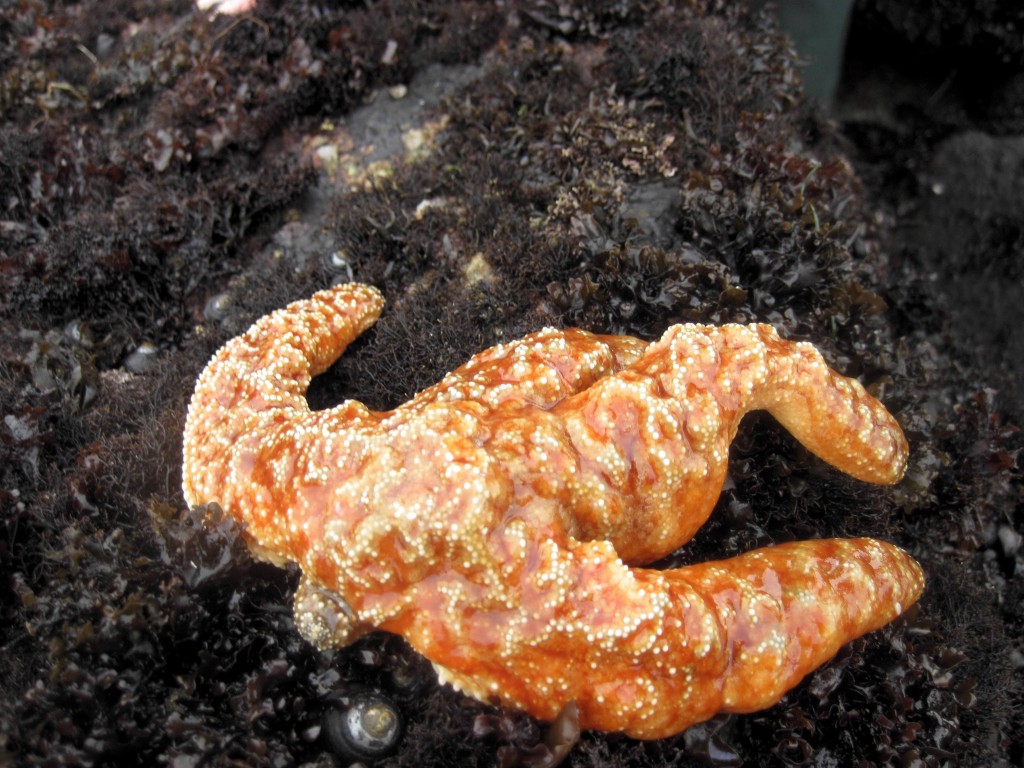
“I hate being stuck behind a desk,” said Hewson, who spent his high school and college years in Australia scuba diving, snorkeling and fishing. “There’s nothing worse than being totally disconnected from the field and trying to make conclusions about things you haven’t really seen.”
In the winter of 2014, Hewson hopped a plane to Vancouver to road-trip the Pacific Northwest and California coasts. The devastation he encountered was overwhelming.
Aquarium keepers in Vancouver took him to the freezers where they kept the carcasses of the fallen. Huge colonies of disease-ravaged stars awaited at seemingly every turn of coastline.
“You have no idea the scale of this disease,” Hewson said. “It’s really just thousands and thousands of kilometers.”
[dropcap letter=”S”]ea stars, and Pisaster ochraceus in particular, are what’s known as a keystone predator. They have a disproportionate effect on their environment relative to other species – meaning if you take them out of the equation, it could seriously alter the ecosystem.
Stars keep the abundance of their prey, namely mussels and urchins, in check. Without their top predators, mussel beds could blanket the intertidal zone, making it uninhabitable for countless species of fish, crustacean and plant life. Swelling urchin populations would likely graze out the kelp forests that numerous marine animals, including sea otters, call home. Without the protection of the kelp, otters would be more vulnerable to their predators: sharks and orcas. The cascading effects could go on and on.
Sea stars may also be particularly sensitive to abnormal ocean conditions related to climate change or pollution, as well as pathogens, because water is constantly circulating their bodies.
“Instead of having blood,” Hewson said, “They have sea water.”
According to scientists, a sea star plague of this magnitude could signal serious trouble for our oceans.
By the spring of 2014, Hewson’s team had completed their study. The results showed that a single-stranded DNA virus, similar to those found in terrestrial insects, was significantly associated with the disease. They called it sea star-associated densovirus.
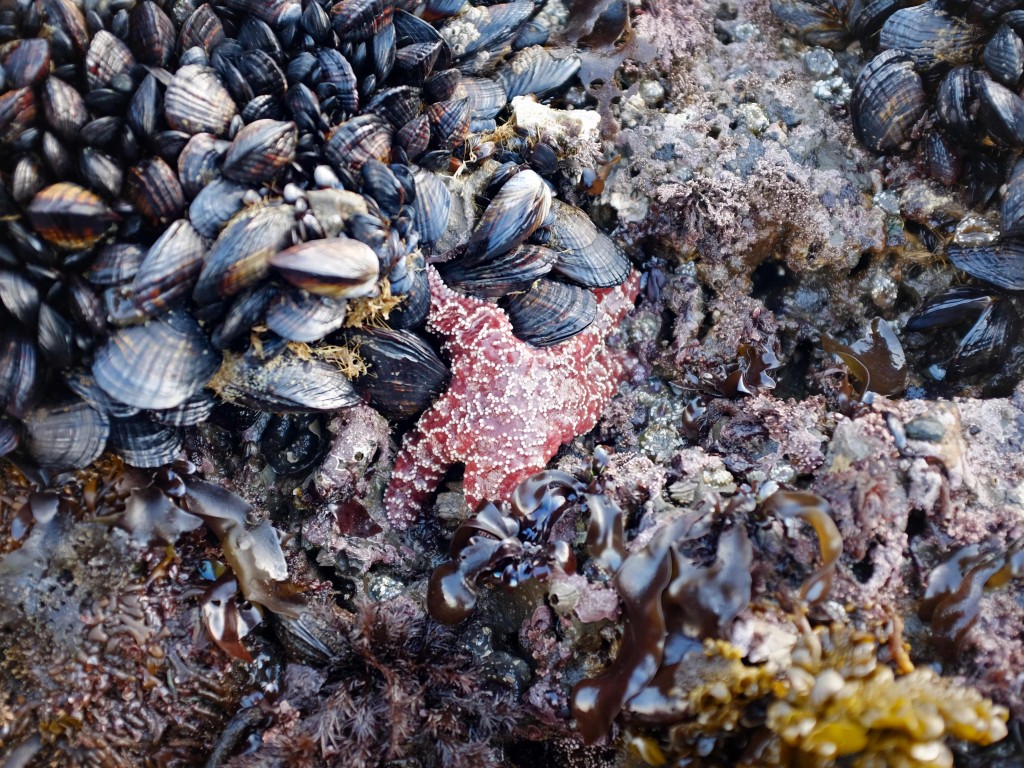
The groundbreaking paper was published in the December 2014 issue of Proceedings of the National Academy of Sciences. Fradkin from Olympic National Park was a co-author.
But despite linking a pathogen to sea-star wasting, Hewson’s research had one finding that made the picture notably more complex. The virus wasn’t just found in diseased specimens. Many healthy stars had it too. The difference was that when they counted up the number of copies of the densovirus within each sample, the tissue extracted from healthy stars had far less.
So, if the virus was present in healthy stars, what was triggering it to replicate out of control and wreak havoc on its host? Solving one mystery had created another.
[dropcap letter=”F”]rom the work done by Hewson, Fradkin and other researchers along the coast, a theory emerged. Perhaps the virus spread from star to star, but then lay dormant until unleashed by some environmental stressor, like changing water temperatures or acidification.
The analogy Hewson makes is to the way viruses manifest in humans.
“Essentially, if you take somebody and you put them in a cold room, they’re going to be stressed out,” Hewson said. “They’re going to invest way more in keeping warm than they are in fending off pathogens. The same thing happens with sea stars.”
But if environmental stress pushes the stars over the edge, scientists are still trying to understand how that plays out. Fradkin has linked wasting outbreaks in Olympic to warm-water blobs blown inland. But researchers in Oregon have found their outbreaks correlate with colder water temperatures.
Hewson believes it’s not one specific thing, but rather a number of different stressors, that can trigger the disease if some threshold is reached. His current research combines tidal monitoring with metagenomics to unravel the complex relationship between the virus and the environment.
To start, Hewson has identified a patch of coastline in Dutch Harbor, Alaska where wasting symptoms have yet to be observed, and where none of the samples collected have shown any trace of the virus. If he can determine when the virus appears in the population versus when the outward signs of disease kick in, Hewson hopes to correlate the wasting outbreaks with specific ocean conditions or weather events.
But Hewson admits that playing the waiting game leaves a lot to the unknown.
“We don’t know if it’s going to happen tomorrow. We don’t know if it’s going to happen in three months. We don’t know if it’s going to happen at all this year,” Hewson said.
[dropcap letter=”S”]ea Star Wasting Disease is still festering in the tidal waters off the western United States. But just as the devastation appeared insurmountable, something surprising happened: the stars began to return.
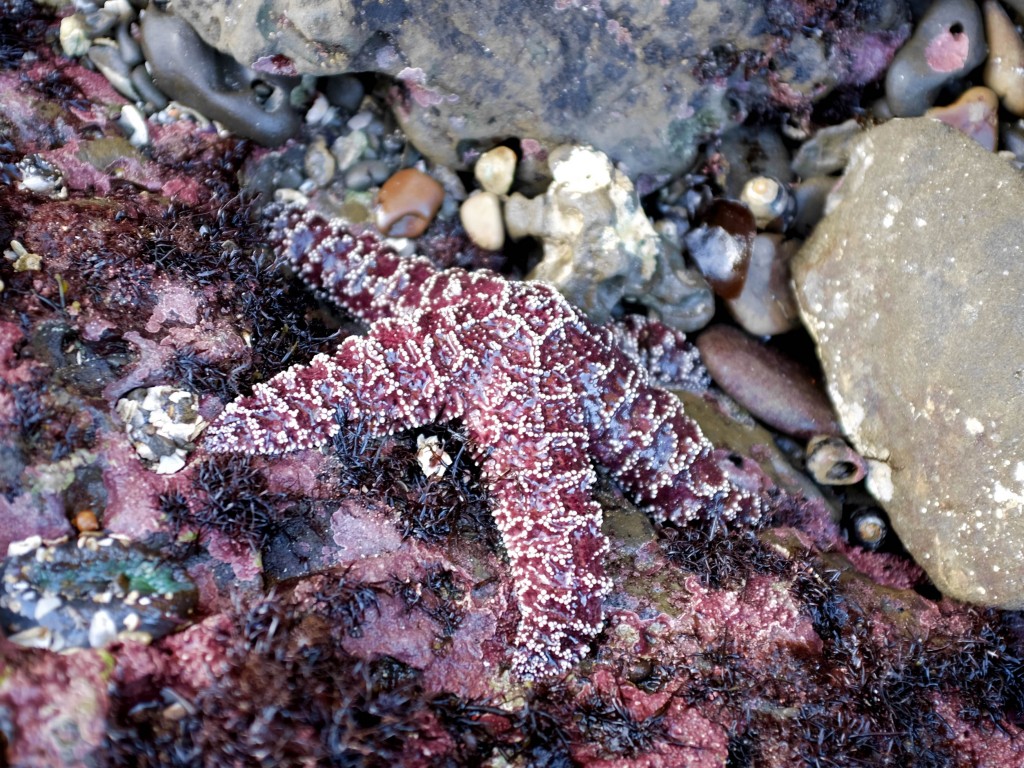
Reports from the Oregon coast in recent years have shown an unprecedented number of baby sea stars. Ochre stars have returned, in smaller numbers, to tide pools that saw none at the height of the wasting. A handful of sunflower stars have been spotted in Washington’s Puget Sound.
The rebound is its own mystery. No one knows if the babies will survive to adulthood or if the population will make a full recovery. And it’s unclear what’s behind the recent surge. Perhaps the new stars are resistant to the virus or less vulnerable to ocean conditions. Perhaps they migrated inland from deeper waters and have yet to fall ill. Time will tell, but scientists remain cautiously optimistic.
The danger, according to Hewson, is that if another large wave of Sea Star Wasting hits the Pacific while the population is still recovering, it could push the stars further toward extinction. One day they might vanish for good.
As ocean climates grow more extreme, ecosystems become more vulnerable to pathogens, and the likelihood of future epidemics increases. A single drop of sea water contains roughly ten million viruses. Any number of these could be lurking within marine species, on the verge of outbreak.
The knowledge of ocean pathology gained from the study of Sea Star Wasting Disease at least gives researchers a foundation to build off. Hewson says the more they can learn about the wasting, the better chance they’ll have at heading off another plague before the fallout becomes irreparable.
[dropcap letter=”L”]ow tide hits Central California’s Pillar Point at 3:37 p.m. on Jan. 25, 2017. A group of two marine biologists and seven civilians march past the sand onto the rocks toward the horizon. Surf grass shimmers in all directions, blanketing the terrain in an emerald glow. When they hit their marker, a metal bolt screwed into one of the rocks, the group measures out a circular plot ten meters in diameter and begins counting.
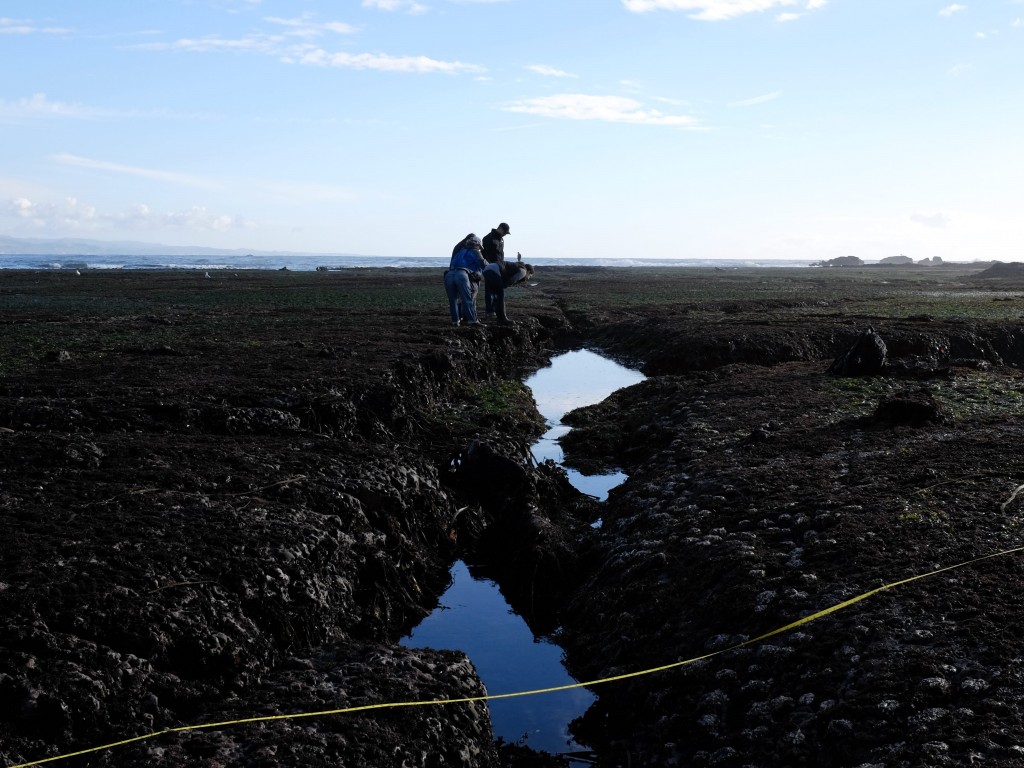
The Citizen Science team from San Francisco’s California Academy of Sciences, led by Rebecca Johnson and Alison Young, is one of many groups that monitors tide pools along the West Coast. Their program allows local volunteers to learn more about the nature surrounding them, while helping collect the scientific data needed to study and protect it.
Marine scientists have come to rely on these efforts, as well as anecdotal reports from divers and fisherman, to keep abreast of coastal issues. Hewson and other researchers credit teams like the one from the California Academy as being essential to the study of Sea Star Wasting Disease.
Before the fall of 2013, as many as 95 stars could be clustered in the plot off Pillar Point. On their first visit after the wasting hit, Johnson and Young found two on the entire reef. In the months that followed, many of the stars they saw appeared flimsy and weak, had lesions or were missing limbs. Three-and-a-half years later, they still discover sick stars on occasion.
With the sun reflecting off the surface of the pools, it can be difficult to spot a star. They often squeeze into nooks between rocks as they engulf the urchins and mussels they prey upon. But after you notice one, the others are hard to miss.
Today, the group finds more adult ochre stars than they’ve seen in a while. Big healthy purple ones. Orange ones, too. None show any sign of wasting.
The sea star population at Pillar Point isn’t what it used to be. Johnson estimates it’s reached about thirty percent of pre-wasting levels. But the stars are a welcome sight, and from the abundance of sea slugs, anemones, urchins and other critters the team documents this afternoon, the ecosystem appears to be thriving.
As the sun goes down and the tide begins to creep back in, a pint-sized red octopus emerges from underneath a rock. Its arms oscillate in harmony as it bounds through the water. Just as quickly as it appeared, the creature returns to shadows. A group clusters around the pool to reflect on the brief sighting. It’s one more reminder of how elusive the underwater world can be.
The audio report originally published on Stanford’s “Generation Anthropocene” podcast.
